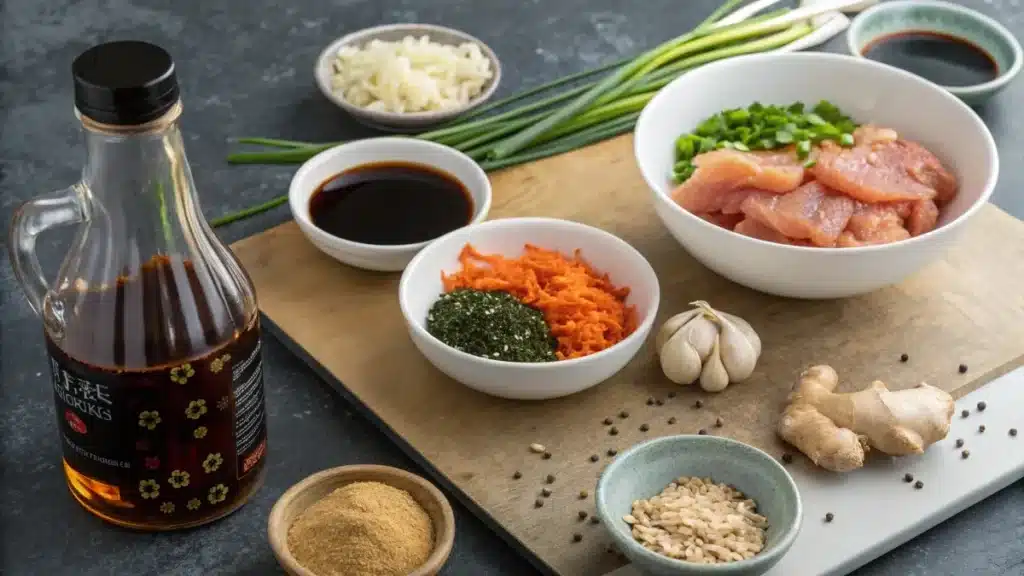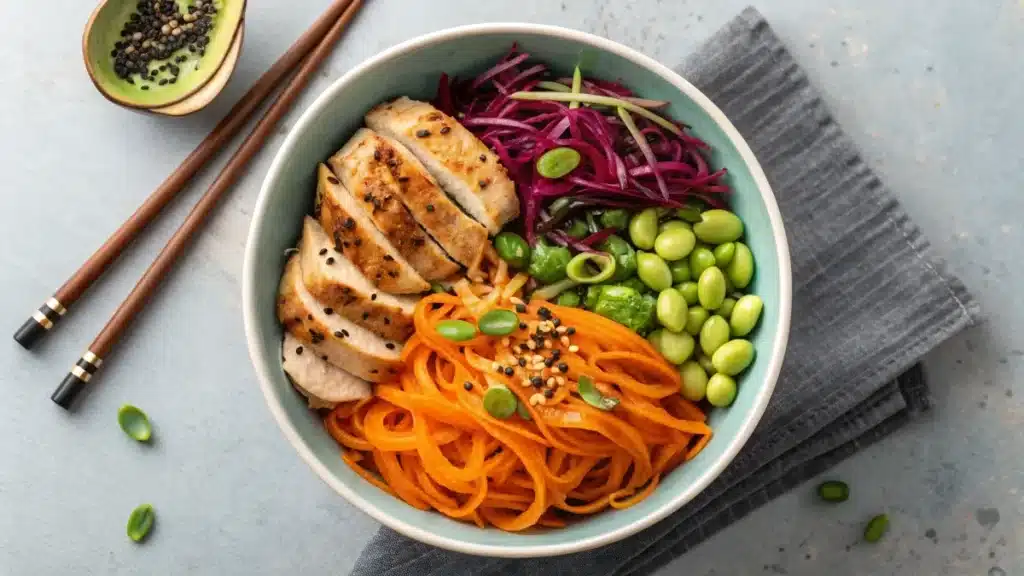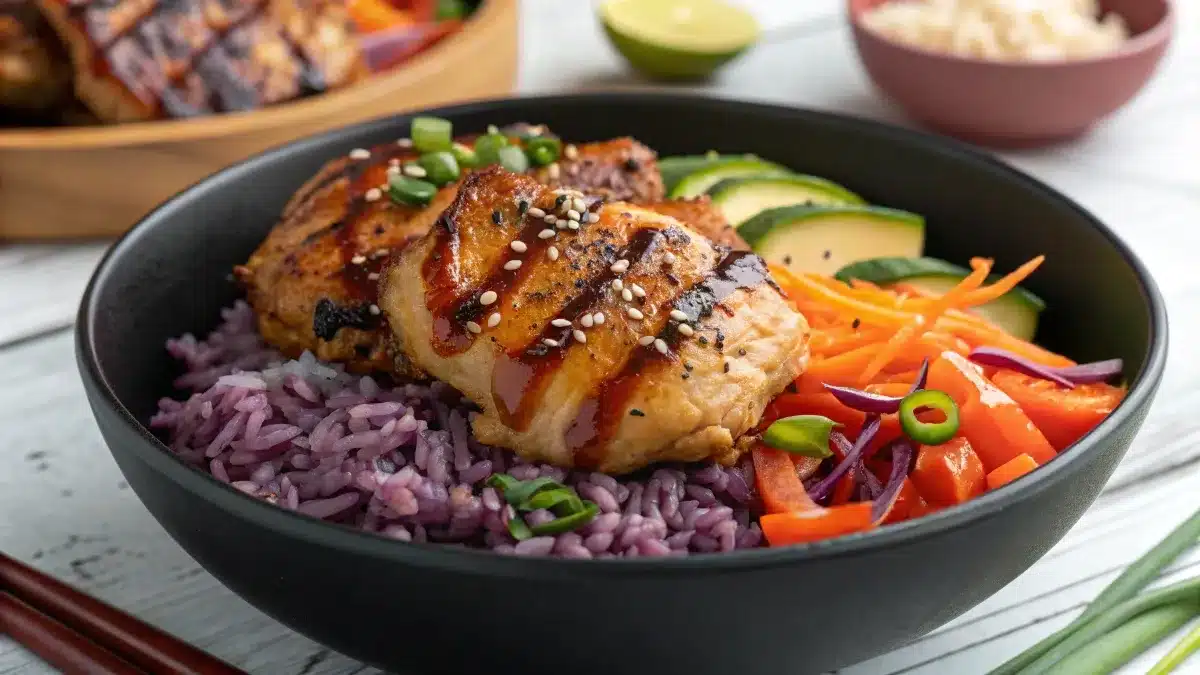Bibibop Chicken Marinade Recipe: The Secret to Irresistible Korean-Inspired Flavor
If you’ve ever had a bite of Bibibop’s flavorful chicken, you know it’s more than just another bowl topping—it’s a full-blown obsession. What sets it apart? The mouthwatering Bibibop chicken marinade recipe. This article breaks down the secrets behind the flavor, walks you through how to make it at home, and offers variations to suit any dietary need. Whether you’re meal prepping, building a Korean-inspired rice bowl, or just craving juicy marinated chicken, we’ve got you covered.
Discover great ideas like this Easy Asian Chicken Marinade to start building your perfect Bibibop copycat bowl.
Table of Contents
The Bibibop Chicken Craze
– Why Bibibop Chicken Is So Popular in the U.S.
Bibibop Asian Grill launched with a clear mission—to bring balanced, flavorful Korean-inspired food to fast-casual dining. At the center of it all is their signature chicken, soaked in a rich, savory-sweet marinade. Bibibop’s growth skyrocketed thanks to this crowd-favorite protein, known for its tenderness and its perfectly balanced glaze.
American diners were quick to embrace Bibibop’s approach: customizable bowls, wholesome ingredients, and bold flavor without artificial additives. But it’s the Bibibop chicken marinade recipe that stole the spotlight. Unlike bland grilled chicken found at many fast-casual chains, Bibibop’s version delivers bold Korean barbecue vibes without overpowering the rest of the bowl.
Don’t miss our Garlic Parmesan Chicken Pasta if you’re looking to balance rich marinades with creamy comfort food.
– The Origins of Bibibop’s Korean Chicken Style
Bibibop is rooted in the tradition of bibimbap, a Korean dish meaning “mixed rice with meat and vegetables.” The restaurant adapts this concept with an American twist, offering clean, customizable meals. Their chicken marinade pulls from Korean staples like soy sauce, sesame oil, garlic, and gochujang, blending them with a Western-friendly sweetness and simplified preparation process.
What makes their version distinct from traditional Korean BBQ chicken (like dak galbi) is its versatility and health-conscious formulation. It’s grilled, not fried. It’s marinated just enough to soak in flavor but not so long it turns mushy. And it’s free from MSG and artificial ingredients.
Looking for inspiration? Try this flavor-packed Smothered Chicken Recipe that also features rich seasoning blends.
While Bibibop keeps their exact recipe under wraps, recreating it at home is totally possible—and in the next section, we’re going to crack that code.
Decoding the Bibibop Chicken Marinade Recipe
– Core Ingredients in an Authentic Bibibop Marinade
The real star of any Bibibop bowl is the chicken—and it’s all about the marinade. While Bibibop hasn’t made their recipe public, years of taste testing, kitchen experiments, and insider research point to a winning combination that’s both simple and flavor-packed.
Here’s a close approximation of the Bibibop chicken marinade recipe based on known flavor profiles and Korean culinary tradition:
| Ingredient | Purpose |
|---|---|
| Soy Sauce | Salty umami base |
| Brown Sugar | Sweetness and caramelization |
| Garlic (minced) | Aromatic punch |
| Fresh Ginger | Spicy, warm undertones |
| Sesame Oil | Nutty, rich aroma |
| Gochujang (Korean chili paste) | Heat and deep flavor |
| Rice Vinegar | Brightness and tang |
| Water or Broth | Dilutes for consistency |
The blend brings together the classic Korean trifecta: salty, sweet, and savory. Gochujang is a non-negotiable for that hint of heat and fermented depth.
Want to see this in action? Learn more about our Chicken Mushroom Masala that layers savory spices just like this marinade does.
This recipe works best with boneless, skinless chicken thighs or breasts. Chicken thighs hold up better to high-heat cooking and absorb the marinade more fully due to their fat content.

– Flavor Profiles: Sweet, Savory, and Umami Harmony
Bibibop’s marinade stands out for its umami-rich balance. Unlike simple soy-based marinades, this one introduces:
- Sweetness from brown sugar: A key to caramelizing the chicken during cooking. It also offsets the saltiness of soy sauce and the spice of gochujang.
- Fermented heat from gochujang: This paste isn’t just spicy—it’s earthy and complex, giving the marinade a signature Korean edge.
- Nutty depth from sesame oil: A small amount goes a long way in adding aromatic richness.
- Garlic and ginger: The backbone of almost every Korean marinade, these two bring warmth, brightness, and a savory base layer.
These flavors are designed not just to coat the chicken, but to seep into every fiber of the meat during the marinating process. The end result? Juicy, flavorful bites that taste like they came straight out of Bibibop’s kitchen.
Check out the Delicious Hibachi Chicken for another bold and balanced Asian-style chicken you can make at home.
Step-by-Step Bibibop Chicken Marinade Instructions
– How to Mix the Marinade: Ingredient Ratios
Crafting the perfect Bibibop chicken marinade recipe starts with balance. You don’t need fancy tools—just a bowl, a whisk, and about 10 minutes of your time. Below is a reliable ratio you can scale based on how much chicken you’re making.
Standard Bibibop-Style Marinade (for 2 lbs chicken):
| Ingredient | Amount |
|---|---|
| Soy Sauce | ½ cup |
| Brown Sugar | 3 tablespoons |
| Sesame Oil | 2 teaspoons |
| Gochujang | 1 tablespoon (adjust to taste) |
| Garlic (minced) | 3 cloves |
| Ginger (freshly grated) | 1 tablespoon |
| Rice Vinegar | 2 tablespoons |
| Water or Chicken Broth | ¼ cup |
Pro Tip: Mix all the ingredients in a bowl, then whisk until the sugar is fully dissolved. Taste before using—you want a balance of sweet, salty, and tangy with a hint of spice.
Want to build out your full Bibibop-style meal? Check out these Chipotle Honey Chicken Tacos for extra marinade techniques and spice variations.
– Marinating Chicken Like a Pro: Timing, Tools, and Tips
Once your marinade is ready, it’s time to let the chicken soak it up. Here’s how to do it right:
1. Choose the Right Cut
Opt for boneless, skinless thighs for max flavor and tenderness. Breasts work too but can dry out faster.
2. Use a Zip Bag or Bowl
Place chicken and marinade in a zip-top bag, seal, and massage it gently. This ensures even coating. You can also use a glass or stainless steel bowl with a lid.
3. Marinating Time Guidelines
| Time | Flavor Penetration |
|---|---|
| 30 minutes | Light flavor |
| 2–4 hours | Balanced and tender |
| Overnight (8–12 hrs) | Deep, intense flavor |
Avoid marinating for more than 24 hours, especially if the marinade has vinegar—it can break down the meat too much.
4. Refrigerate and Rotate
Always marinate in the fridge—not on the counter—for food safety. Turn the chicken halfway through if it’s in a bowl.
Looking for another flavorful recipe with perfect marinade-to-meat ratios? Don’t miss our Chicken Philly Cheesesteak packed with bold spices and juicy results.
5. Remove Excess Marinade Before Cooking
Wipe off extra marinade before cooking. It’ll prevent burning and allow your chicken to caramelize properly.
Whether you grill it or pan-sear it, this marinated chicken will deliver that same Bibibop satisfaction, right at home.
How to Cook Bibibop-Style Chicken Perfectly
– Grilling, Baking, or Pan-Searing: Which Method Is Best?
Once your chicken is bathed in that delicious Bibibop chicken marinade recipe, the next big decision is how to cook it. The cooking method can make or break your dish—not just in texture, but in flavor delivery too.
Here’s a breakdown of the best options to get that Korean-style Bibibop finish:
1. Grilling (Most Authentic Taste)
Grilling over medium-high heat brings out caramelization, char, and smoky depth—just like Bibibop’s chicken.
How to do it:
- Preheat your grill to 375–400°F
- Brush grates with oil
- Grill thighs 6–7 minutes per side or until internal temp reaches 165°F
- Let rest 5 minutes before slicing
2. Pan-Searing (Quick & Flavorful)
No grill? No problem. A skillet delivers crisp edges and juicy meat.
How to do it:
- Use a cast iron or stainless steel pan
- Heat 1–2 tsp of oil over medium-high
- Add chicken, cook undisturbed for 5–6 minutes
- Flip and cook an additional 4–5 minutes
Pro Tip: Don’t crowd the pan. Cook in batches to get proper sear.
3. Baking (Meal Prep Favorite)
If you’re cooking in bulk or prepping for the week, baking is foolproof.
How to do it:
- Preheat oven to 400°F
- Place chicken on a parchment-lined tray
- Bake for 20–22 minutes
- Broil last 2 minutes for a crispy finish
All methods lock in the marinade’s flavor—choose based on your setup and needs.
– What Oil Does Bibibop Use to Cook?
While Bibibop hasn’t disclosed every detail, it’s widely known that they use light sesame oil and canola oil in their cooking process. These oils:
- Withstand high heat without smoking
- Add a subtle nutty flavor
- Let the marinade shine without overpowering it
In your home kitchen, go with toasted sesame oil for flavor and canola or avocado oil for high-heat cooking. Never cook with sesame oil alone over high heat—it burns quickly.
For a similar seared result with rich notes, Learn more about Dutch Oven Chicken Breast—perfect for keeping meat tender and juicy.
Bibibop Bowl Copycat at Home

– The Bases at Bibibop: What Goes Under the Chicken
Once your marinated chicken is grilled or pan-seared to perfection, it’s time to build the full Bibibop-style bowl. Just like Chipotle has rice and beans, Bibibop offers a range of base options that bring variety and texture to the dish.
Here’s what you’ll find at Bibibop—and how to replicate it at home:
| Bibibop Base Option | How to Make at Home |
|---|---|
| White Rice | Use jasmine or short-grain rice for authenticity |
| Purple Rice | Mix white rice with black rice (1:1 ratio) for color + fiber |
| Sweet Potato Noodles (Japchae) | Use Korean glass noodles sautéed in sesame oil |
| Salad Greens | A simple spring mix or chopped romaine works |
| Cauliflower Rice (low-carb) | Lightly sauté for texture, season with garlic salt |
The rice is typically served warm, while noodles or greens can be hot or cold depending on your preference. This mix-and-match flexibility is what makes Bibibop such a hit.
Check out our Edamame Rice Recipe for another Korean-inspired base that pairs beautifully with marinated chicken.
Want more variety? Combine a grain with a salad for texture contrast and added volume. Top that with the freshly cooked chicken—and then comes the fun part.
– Toppings, Sauces, and Presentation Tips
Bibibop’s power lies in its layering of flavors and textures. After choosing your base and protein, it’s time to load up on colorful toppings and flavorful sauces.
Top Toppings to Include:
- Pickled carrots or daikon
- Corn
- Cucumber slices
- Edamame
- Bean sprouts
- Kimchi
- Shredded cheese (American fusion twist)
- Fresh cilantro or green onion
Essential Sauces:
- Yum Yum Sauce – creamy, slightly sweet, slightly tangy
- Spicy Sriracha Mayo – for heat lovers
- Sesame Ginger Dressing – light and tangy
- Teriyaki Sauce – adds a sweet glaze on top
If you’re going full DIY, make a quick Yum Yum sauce by combining mayo, ketchup, garlic powder, sugar, and a touch of rice vinegar.
Don’t forget presentation. Place the base first, fan out the toppings in sections, then place sliced chicken at the center. Finish with a drizzle of sauce and a sprinkle of sesame seeds.
Don’t miss our Vegan Yum Yum Sauce Recipe for a plant-based version of this fan-favorite topping.
This bowl isn’t just tasty—it’s highly customizable and perfect for meal prep. In the next section, we’ll talk about substitutes for Bibibop sauce ingredients and alternative marinade options.
Ingredient Breakdown & Substitutes
– What Are the Ingredients in Bibibop Sauce?
Bibibop doesn’t offer a one-size-fits-all sauce. They provide a sauce bar of Korean-inspired options, but the most iconic sauces are:
1. Yum Yum Sauce
A creamy, tangy blend often made with:
- Mayonnaise
- Ketchup
- Garlic powder
- Paprika
- Rice vinegar or lemon juice
- Sugar or honey
2. Spicy Sriracha Mayo
Perfect for heat lovers, made with:
- Mayo
- Sriracha
- Lime juice
- Pinch of sugar
3. Sesame Ginger Vinaigrette
Lighter and tangy, ideal for greens:
- Soy sauce
- Rice vinegar
- Sesame oil
- Ginger and garlic
- A touch of honey or maple syrup
4. Korean BBQ Sauce (used as a glaze)
- Soy sauce
- Brown sugar
- Garlic
- Gochujang
- Water to thin
Want something lighter or dairy-free? These sauces are flexible. You can easily swap mayo with vegan alternatives or use Greek yogurt for a protein boost.
Learn more about how sauces elevate your dishes with this Sour Cream Enchilada Sauce Recipe that blends creaminess and spice.
– Common Marinade Substitutions (Soy-Free, Sugar-Free, etc.)
Looking to adapt the Bibibop chicken marinade recipe to your dietary needs? It’s easier than you think. Here’s how to keep the flavor while switching out certain ingredients:
Soy Sauce Alternatives:
- Coconut aminos (gluten-free & lower sodium)
- Tamari (gluten-free soy sauce variant)
Gochujang Alternatives:
- Sriracha + miso paste
- Chili garlic sauce + a pinch of sugar
Brown Sugar Substitutes:
- Honey
- Maple syrup
- Coconut sugar
- Monk fruit sweetener (keto-friendly)
Rice Vinegar Substitutes:
- Apple cider vinegar
- White wine vinegar + pinch of sugar
No Sesame?
If you’re allergic or don’t have sesame oil, use a neutral oil like avocado or grapeseed, and add a sprinkle of toasted sesame seeds at the end.
Looking for a clean, low-carb variation? Try this Healthy Shredded Chicken recipe that focuses on protein-packed simplicity with flexible seasoning options.
With the right swaps, your homemade Bibibop bowl can suit keto, gluten-free, Whole30, or vegan diets without losing the Korean essence.
How to Marinade Chicken Without Marinade
– Dry Rub Techniques for Korean-Style Chicken
Don’t have time for a long marinade session? You can still bring bold, savory flavor to your chicken without soaking it in liquid. A dry rub is your best friend—and it can mimic the key flavor notes in the Bibibop chicken marinade recipe.
Here’s a quick Korean-inspired dry rub that works perfectly when you’re in a rush:
| Ingredient | Amount |
|---|---|
| Brown sugar | 1 tablespoon |
| Garlic powder | 1 teaspoon |
| Ground ginger | 1 teaspoon |
| Smoked paprika | 1 teaspoon |
| Sea salt | 1 teaspoon |
| Black pepper | ½ teaspoon |
| Gochugaru (Korean chili flakes) or cayenne | ½ teaspoon |
| Optional: Five-spice powder | ¼ teaspoon |
How to use it:
- Pat the chicken dry first
- Sprinkle and rub the spices thoroughly over each piece
- Let it sit for 15–30 minutes (or longer if you have time)
- Cook as usual: grill, pan-sear, or roast
The sugar will help create a slight caramelized crust while the spices infuse flavor fast. This technique is ideal for meal prep, grilled dishes, or weeknight dinners when time is tight.
Check out this Crockpot Loaded Steak and Potato Bake for another easy rub-based flavor bomb.
– Brining and Infusing Flavor in Alternative Ways
Another great way to add flavor without a traditional marinade is brining. Unlike marinades, which focus on surface flavor, brining uses salt to enhance moisture and juiciness from the inside out.
Simple Chicken Brine (for 2 lbs of chicken):
| Ingredient | Amount |
|---|---|
| Water | 4 cups |
| Kosher salt | ¼ cup |
| Brown sugar | 2 tablespoons |
| Garlic cloves | 2, smashed |
| Ginger slices | 4–5 thin slices |
| Optional: Soy sauce | 2 tablespoons |
Steps:
- Mix all ingredients until salt and sugar dissolve.
- Add raw chicken and refrigerate for 30 minutes to 4 hours.
- Rinse and pat dry before cooking.
This process is especially helpful if you want juicy chicken and don’t have time to wait for a long marinade. It also works beautifully with grilled or oven-roasted chicken and can be finished with a glaze or sauce.
Bonus: Add Korean flavors like gochugaru or sesame oil to the brine for extra authenticity.
Korean Crispy Chicken: Is It Different From Bibibop?

– What Are the Ingredients in Bibibop Korean Crispy Chicken?
If you’ve ever tried Bibibop’s Korean crispy chicken, you already know it’s a flavor-packed upgrade with a totally different texture compared to their grilled version. But is it the same chicken just fried? Not quite.
Bibibop’s crispy chicken starts with a marinated base, likely the same or very similar to their classic grilled version using soy sauce, brown sugar, garlic, and gochujang. However, what makes it stand out is the crispy coating that gives it that irresistible crunch.
Here’s what typically goes into a Korean-style crispy chicken like Bibibop’s:
| Ingredient | Purpose |
|---|---|
| Chicken thigh or breast | Juicier cuts are preferred |
| Soy-based marinade | Adds umami depth |
| Potato starch or cornstarch | For extra crisp coating |
| Garlic & ginger | Essential Korean aromatics |
| Gochugaru or chili powder | Adds color and mild heat |
| Oil for frying | Canola or vegetable oil |
Key difference: Crispy Bibibop chicken is dredged in starch, then flash-fried to golden perfection. This technique locks in juices while adding that addictively crunchy layer.
Unlike American-style fried chicken, Korean crispy chicken is light, airy, and not greasy, thanks to thinner coatings and faster cooking times.
Don’t miss our Bang Bang Salmon Bites for another crispy, saucy, Korean-inspired dish with a similar sweet-spicy flavor.
– Texture, Coating, and Frying Differences Explained
Let’s break it down:
| Feature | Grilled Chicken (Bibibop) | Crispy Chicken (Bibibop) |
|---|---|---|
| Texture | Tender, slightly charred | Crunchy outside, juicy inside |
| Cooking Method | Grilled or seared | Deep-fried or air-fried |
| Coating | None | Starch-based dry coating |
| Flavor Absorption | Moderate | High, especially post-fry sauces |
| Best For | Health-conscious eaters | Flavor and texture lovers |
Pro Tip: You can replicate Bibibop’s crispy chicken at home by marinating your chicken, patting it dry, coating it in potato starch, and shallow frying in a skillet. For a healthier version, try an air fryer at 400°F for 10–12 minutes.
Want to create the perfect crispy crunch at home? Try pairing it with our Gluten-Free Fettuccine Alfredo for a fusion dinner that’s creamy and crunchy all in one bite.
Bibibop vs Chipotle: Business and Ownership
– Are Bibibop and Chipotle Owned by the Same Company?
With so many similarities—build-your-own bowls, assembly-line service, and fresh ingredients—it’s no surprise that people often ask, “Are Bibibop and Chipotle owned by the same company?”
The answer is no.
Bibibop and Chipotle are two entirely separate businesses:
| Brand | Ownership | Founded |
|---|---|---|
| Bibibop | Gosh Enterprises (also owns Charleys Philly Steaks) | 2013 |
| Chipotle | Publicly traded company (NYSE: CMG) | 1993 |
Bibibop was founded in Columbus, Ohio, with a clear focus on bringing Korean-inspired flavors to the American fast-casual space. While it might look and feel like a “Korean Chipotle,” the operations, recipes, and leadership are completely different.
Interestingly, Bibibop expanded rapidly in 2017 by purchasing many former ShopHouse locations, which was Chipotle’s now-defunct attempt at an Asian-style restaurant.
Learn more about how fusion dining works in the U.S. by checking out our Mexican Street Corn Dip—a perfect blend of cultural flavor and fun presentation.
– Comparing Brand Philosophies and Menu Styles
Even though they serve their meals similarly, the philosophies behind the two brands set them apart:
Bibibop’s Focus:
- Korean-inspired ingredients like gochujang, purple rice, kimchi
- Customizable bowls with a lighter, cleaner focus
- All gluten-free menu
- More variety in vegetarian and Asian-fusion flavors
Chipotle’s Focus:
- Mexican-American fusion: burritos, tacos, rice bowls
- Emphasis on responsibly sourced meat
- High-calorie, hearty portions
- Heavily meat-centric
While both promote clean eating, Bibibop emphasizes balance and lightness, often making it the go-to for people wanting bold flavors with fewer calories and less heaviness.
If you love the simplicity of Chipotle but crave something lighter and packed with Korean flair, Bibibop is your perfect match. And when you can replicate their chicken marinade recipe at home, you don’t even have to leave your kitchen.
Conclusion
Craving the flavor of a Bibibop bowl without leaving your house? Now you can make it yourself from start to finish. This Bibibop chicken marinade recipe brings authentic Korean flavors right to your dinner table—whether you grill it, crisp it, or meal-prep it for the week ahead.
From the sweet-umami marinade made with soy sauce, gochujang, and sesame oil, to perfectly cooked chicken laid over rice, greens, or noodles, you’ve got everything you need to recreate that bold Bibibop experience. And with all the tips, sauce recipes, and substitution guides in this article, you can make it your way—spicy, gluten-free, or even keto-friendly.
If you’re still exploring creative Asian-style recipes, don’t miss our Easy Edamame Dumpling Recipe—a great pairing to serve alongside your Bibibop bowl.
FAQs
What are the ingredients in Bibibop sauce?
Bibibop offers several sauces, but their signature ones like Yum Yum sauce and Korean BBQ sauce typically include soy sauce, sesame oil, garlic, gochujang, vinegar, and sweeteners like sugar or honey.
How to marinade chicken without marinade?
Use dry rubs or brining. Dry rubs with garlic powder, brown sugar, and gochugaru can give great flavor fast. Brining with salt, water, and aromatics can tenderize and season the meat from the inside out.
What oil does Bibibop use to cook?
Bibibop commonly uses sesame oil and canola oil for their high-heat cooking methods, which bring out deep flavor and help sear the meat evenly.
What are the bases at Bibibop?
Popular bases include white rice, purple rice, sweet potato noodles (japchae), salad greens, and cauliflower rice.
What are the ingredients in Bibibop Korean crispy chicken?
Bibibop’s crispy chicken is marinated in a soy-based sauce, then coated with potato starch and fried. Ingredients include garlic, ginger, gochujang, and a starch coating.
Are Bibibop and Chipotle owned by the same company?
No. Bibibop is owned by Gosh Enterprises, while Chipotle is an independent, publicly traded company.

